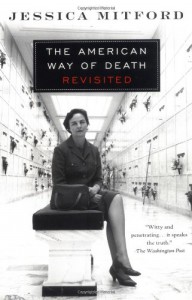
Is Death owned by Big Business?

The American Way of Death Revisited by Jessica Mitford blew my freaking mind. There's no other way to say it. I took 4 pages of notes after finishing it and then bought my own copy so that I could reference back to it. As you might have guessed from the title this is another book about death culture and funeral practices in the United States. (Here are 3 more on the topic: Caitlin Doughty 1 & 2 and Bess Lovejoy.) Mitford gives a comprehensive look at the funeral industry in America up to the last update of her book in 1997. (A small portion of the book compares the US outlook on death with the UK and there is a stark difference.) She does not shy away from making her points about the injustices committed by those working in the funeral industry. She discusses the methods employed by everyone from funeral home directors to gravestone manufacturers. This book was a definite eyeopener in terms of what is actually legal when it comes to the handling of the dead. (Spoiler alert: pretty much everything.)
Alas, poor Yorick! How surprised he would be to see how his counterpart of today is whisked off to a funeral parlor and is in short order sprayed, sliced, pierced, pickled, trussed, trimmed, creamed, waxed, painted, rouged, and neatly dressed - transformed from common corpse into a Beautiful Memory Picture. This process is known in the trade as embalming and restorative art, and is so universally employed in the United States and Canada that for years the funeral director did it routinely, without consulting corpse or kin. He regards as eccentric those few who are hardy enough to suggest that it might be dispensed with yet no law requires embalming, no religious doctrine commends it, nor is it dictated by considerations of health, sanitation, or even of personal daintiness. In no part of the world but in North America is it widely used. The purpose of embalming is to make the corpse presentable for viewing in a suitably costly container; and here too the funeral director routinely, without first consulting the family, prepares the body for public display. - pg 43
I include this lengthy quote (and another in a moment) to illustrate the importance of being educated about what your rights are both as the deceased and as the loved one making the arrangements after death. Mitford includes accounts of deliberate fraud by members of the funeral industry against the grieving. (Many funeral homes even include in their pricing grief counseling!) The frauds range from offering 'package deals' with no options for opting out, non-disclosed fees prior to invoicing, refusal to provide itemized statements for services, or inflation on pre-need arrangements (example: plots purchased well before death). I think this is a book that every single person should read because it discusses in depth a topic which is considered taboo in our country but until it is talked about openly and frankly as Mitford does the funeral industry under its many guises will continue to take advantage of the average consumer. Know your rights, people! 10/10
And speaking of rights I'd like to leave you with this bit of advice from the last chapter of Mitford's book:
Send a friend to two or more mortuaries to obtain their general price lists and casket prices. Ask for the cost of direct cremation, including transportation costs and crematory fees. Likewise, for the cost of immediate burial. Pay no money in advance. If death has not yet occurred and you wish to pay in installments, do so by setting up a Totten Trust, naming yourself or a relative or close friend as beneficiary. Remember, above all, that many funeral homes have a "no-walk" policy, which means simply that if and when you start to walk out, the fee will come down, down, down until a level acceptable to you is reached. - pg 274
What's Up Next: The Guernsey Literary and Potato Peel Pie Society by Annie Barrows & Mary Ann Shaffer
What I'm Currently Reading: Condoleezza Rice: A memoir of my extraordinary, ordinary family and me by Condoleezza Rice
 1
1
 3
3















